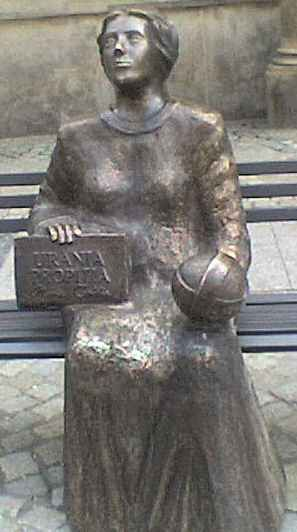Biography
Maria Cunitz (1610-1664) was born in Wołów (Silesia, a territory located in present-day Poland, but historically within Germany and the Czech Republic).
She was the eldest daughter of the physician Heinrich Cunitz and Maria Scholtz, daughter of the German mathematician Anton von Scholtz (1560-1622).
She received a careful education thanks to tutors hired by the family. By the age of ten, Maria spoke Hebrew, Greek, Latin, German, Polish, Italian and French.
In addition to showing a certain talent for painting, music and poetry, she learned mathematics, medicine and history, which was unusual for a woman at the time. Because of her great knowledge and her later contributions to science and culture, she was known as the “Silesian Pallas" (Pallas was the god of wisdom in Greek mythology).
In 1623 she married but was widowed in 1626. In 1630 she married the physician Elias von Löwen, an amateur astronomer with whom she observed the planets.
Her main work - written in German and Latin - was "Urania Propitia". She wrote it during the Thirty Years' War (1618-1648) on the grounds of the Cistercian convent in Łubnice, where she and her husband took refuge. Let us remember that Urania is the muse of astronomy in Greek mythology; and Maria was also known by that name, Urania.
When the couple returned to Silesia in 1650, they published Maria's book with their own funds.
"Urania propitia" contained a simplification of the well-known Rudolphine Tables of Johannes Kepler (1571-1630): these included logarithms, which complicated the reading.

In her treatise, Maria corrected some errors she had detected in the astronomical tables for the planetary motions of the astronomer Johannes Kepler, included new mathematical tables simplifying the calculations, new planetary ephemerides and divulged part of Kepler's theories. Today, her text is also regarded as a contribution to the development of scientific German. In fact, she probably wrote it in this language - in addition to Latin - in order to make it more widely known.
With her book Maria spread Kepler's second law, which we could simplify by saying that the planet will move faster the closer it is to the Sun.
In the introduction to "Urania propitia", Elias von Löwen, her husband, made it clear that the work was Maria's and not his. However, and probably to avoid the reluctance of scientists who would not want to discuss astronomy with a woman, Maria and Elias together began an extensive correspondence with other astronomers.
"Urania propitia" gave Maria a great reputation in Europe, being acclaimed as the wisest woman in astronomy after Hypatia of Alexandria. It is named after the crater Cunitz on Venus and the minor planet 12624 Mariacunitia.
In 1656, a fire destroyed the house of Maria and Elias. Everything disappeared: the scientific documents, the data of his observations, the correspondence with other astronomers, the instruments and the chemical products used to make medicines. Their income declined considerably. Elias died in 1661 and Maria three years later.
Extracted from Wikipedia (04/01/2022) https://es.wikipedia.org/wiki/Maria_Cunitz
Extracted from Mujeres con ciencia (04/01/2022) https://mujeresconciencia.com/2016/09/12/maria-cunitz-la-palas-de-silesia/
Bibliography
- Alic, Margaret (1991). El legado de Hipatia. Madrid: Siglo veintiuno de España editores.
- Antolín Herrero, María Sol (2020). “María Cunitz, una astrónoma que perfeccionó las teorías de posicionamiento de los planetas”, el diario feminista, 09/04/2022, <https://eldiariofeminista.info/2020/03/28/maria-cunitz-una-astronoma-que-perfecciono-las-teorias-de-posicionamiento-de-los-planetas/>
- Figueras, Lourdes; Molero, María; Salvador, Adela y Zuasti, Nieves (1998). Género y matemáticas. Ed: Síntesis.
- Macho Stadler, María (2016). “Maria Cunitz, la ‘Palas de Silesia’”, Mujeres con ciencia, Universidad del País Vasco, 09/04/2022, <https://mujeresconciencia.com/2016/09/12/maria-cunitz-la-palas-de-silesia/>

